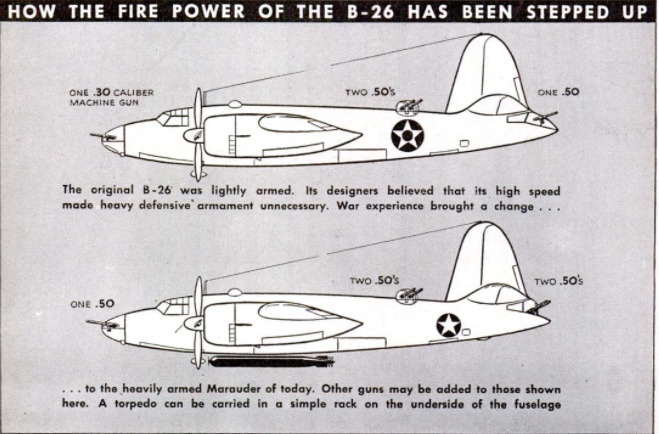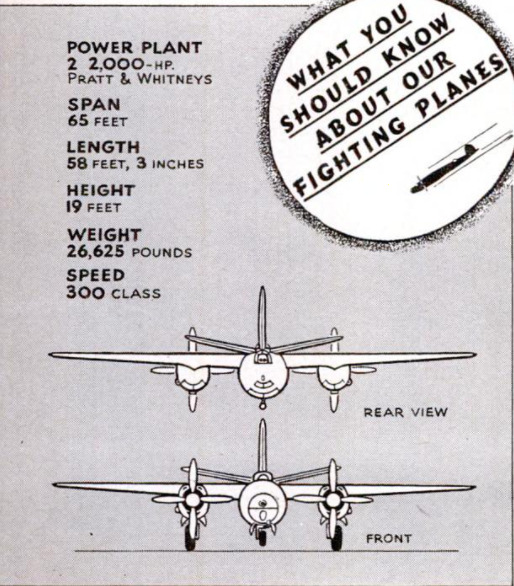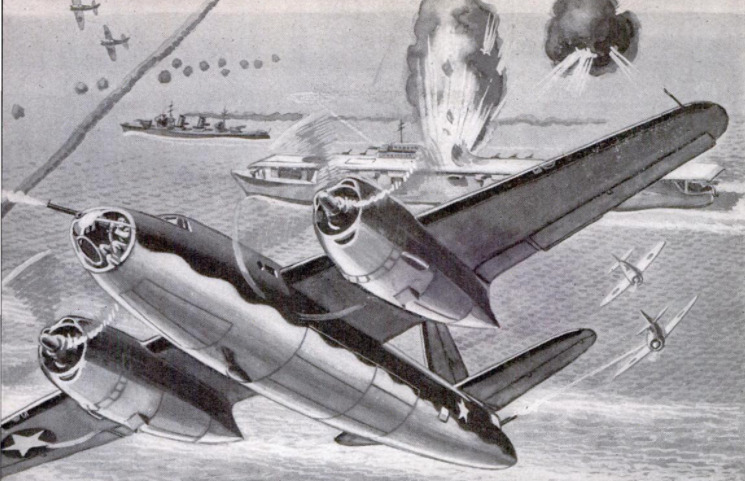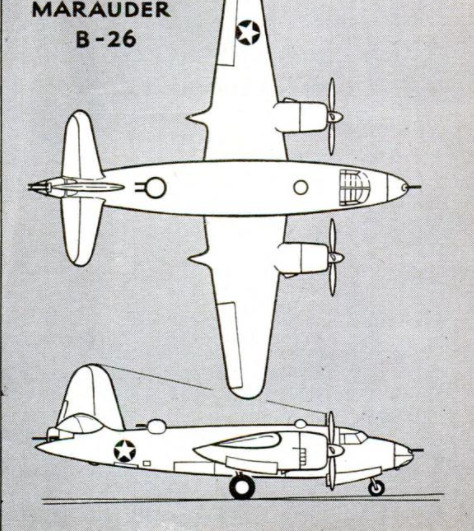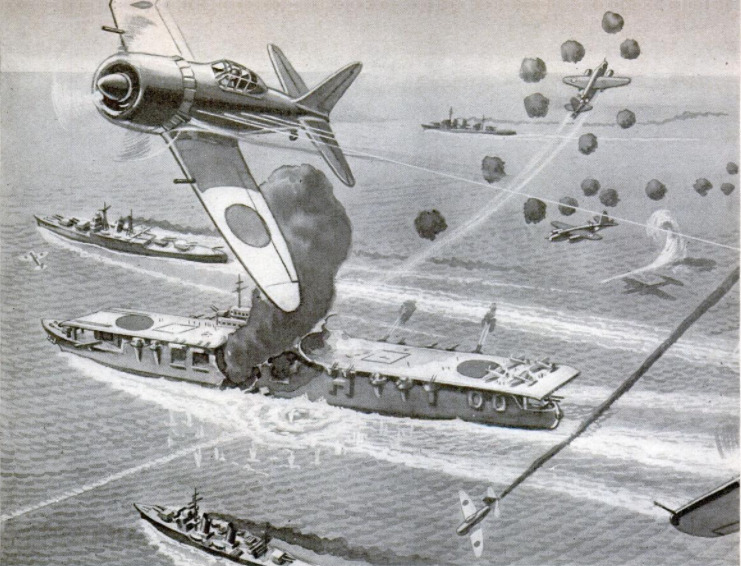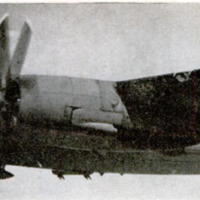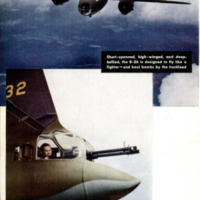-
Titolo
-
The B-26 "Marauder"
-
Article Title and/or Image Caption
-
Title: The army asked for a miracle...the answer was the B-26
-
Subtitle: How Glenn L. Martin built medium bomber that flies like a closed-course racer
-
extracted text
-
IF THE Japanese have not developed any
profanity in their language in 2,000 years,
they must be thinking up some at this late
date to describe the U.S. Army's B-26
medium bomber.
On this side of the Pacific, no well-in-
formed observer has offered a temperate
opinion of this airplane. It has either fast
friends or outspoken critics. But there is
no doubt that the B-26 is the fastest, fight-
ingest, most omnery twin-engined medium
bomber produced to date. It flies at near
pursuit speed, turns like a fighter, and has
a tricycle landing gear that allows it to
operate from bases usually staked out for
fighter planes.
The B-26 had a swift, almost tumultuous
beginning. Shortly before the march on
Poland, the major planners of American
war strategy saw that we might have to
fight beyond the seas. Before this time, the
belief that we could operate from our own
hemisphere had produced the Flying For-
tress and similar long-range craft. Events
in 1939 dictated a radical change in that
policy. To supplement the Boeing B-17’s, a
fast, shorter-range bomber, capable of sink-
ing ‘a battleship should it slip inside the
long-range patrol, seemed to be required.
The original theory was that if such a
bomber was extremely fast, it could get
away with light defensive armament, de-
pending on high speed for its own protec
tion against the enemy fighter opposition.
The bid for an airplane of this type
went out to the nation’s manufacturers.
The Glenn L. Martin Company in Baltimore
took the proposition under consideration
and asked the engineering staff to submit
proposals in the form of three-view draw-
ings. Several sets of sketches were sent in.
They were set up for study and disccussion
before the entire staff. Then iron-haired,
steel-eyed Glenn L. Martin walked in, sur-
veyed the half-dozen proposals and, after a
couple of minutes, pointed to one. “That's
it!” He picked out a proposal set forward
by the brilliant nonconformist, Peyton Ma-
gruder.
Some of the engineers who studied the
Army's demands had asked, “When do they
want this miracle passed?” The general
opinion, at first, was that the Army was
asking for the impossible. That was all that
was needed. It seems that the Army's cur-
rent motto, “The difficult performed im-
mediately, the impossible takes a little
longer,” started with Magruder and the
specialists who worked with him.
Most men would have gone about picking
up where their predecessors left off. Ma-
gruder heaved most current ideas for
bomber design out the door, welcoming
such notions as all-plastic transparent
noses, and streamlined fuselages that simu-
lated theoretical blackboard illustrations.
He drew as perfect a set of outer contours
for speed and performance as anyone dared
in a ship that size, then defied the struc-
tures men to design for his theory.
For three weeks the project engineers
lived within the limits of the Martin plan’
near Baltimore, driving a drafting crew
to the verge of collapse as events in Europe
showed more and more the desperate need
for this Kind of airplane—a ship that could
fly like a racer, maneuver like a fighter,
and lift a trucks load.
The proposed bomber was exactly what
most people thought Magruder would trot
out. Short-spanned, high-winged and deep-
bellied, a closed-course racer built big,
packed with the latest radical ideas on air-
plane design.
There was no fussing about peacetime
production frippery. The first B-26 that
came Off the line was the pilot model and
full-scale prototype in ome. Behind it
stretched a production line. The B-26 rep-
resented the longest chance ever taken on
a single design.
The first Marauder appeared in November
1940. It had a span of 65 feet, was 58/3"
long, and was powered by two 1,850-h.p.
Pratt & Whitney Wasp engines. Its top
speed was above 350 m.p.h. The prototype,
unburdened with armament, had an operat-
ing ceiling in the neighborhood of 29,000
feet, and its range ran just a little short of
2,400 miles. With current armament, the
range is approximately 1,300 miles.
The early models were lightly armed.
They toted a .30
caliber machine gun forward and a heavier
one in a light mount in the tail, while the
main weight was borne by the two 50s in
a top power-driven turret.
The day the first Marauder taxied down
the line at Martin's plant, everybody knew
it was going to be plenty hot—and it was.
The ship caught up with a couple of con-
temporary first-line fighters. Its top speed
was so great that good air pictures had
to wait until a second model could be
built. Only a few ships could pull up
alongside to give a photographer a chance
for a shot.
‘There is more to the simple, clean, cigar-
shaped lines of the B-26 than meets the eye.
Probably this was one of the things that
sold the production-wise engineers like
Harry Volmer, the manufacturing boss, and
factory manager Tommy Soden. The fuse-
lage was unusually free from compound
‘curves which are tough to make, tougher to
tool and all but impossible to assemble.
The ship bad been engineered to eliminate
one of the major bugbears of airframe
‘production.
‘As more and more war information rolled
in, it became evident that even a medium
‘bomber must take care of itself in a fight,
and that, despite high speeds, the effective.
mess of a bomber depended on how well it
could fight its way to an objective and
Sght its way back. More guns went onto
the Marauder. The single-gun stinger in
the tal gave way to two 50's. The .30
caliber peashooter that protruded delicately
through the transparent nose was replaced
by a murderous flexible 50.
Most recent addition to the ship's arma-
ment is a simple rack that permits it to
sling a torpedo outside. The first appearance
of this idea at the Battle of Midway, major
proving ground for the B-26, was a com-
plete surprise to the Japanese fleet. A
formation of aircraft carriers was approach.
ing Midway, surrounded by destroyer and
cruiser escort. The plan was for high-flying.
B-17's to “soften up” the enemy, while the
B-26' swept in for the kill. Everything was
OK except that the Fortreases failed to make
contact with the enemy. As a result, when
the four B-26's came in flying low, they were
faced with completely screened naval unit,
still keeping perfect formation. There was
DO Waiting, 10 turning back. ‘The Japs stood
by for a low-fying bomb attack, spreading
formation to minimize hits. The B-26's, tak-
ing advantage of their maneuverability and
speed, dropped close to the water for the
attack. This meant that precious time
was gained us the Jap antiaircraft gun-
ners had to readjust their gun positions.
The B-26's dashed in and delivered thelr
deadly missiles, sinking two of the carriers
right in the middle of the defense forma-
tion.
Performance in the Aleutians, where they
sank two destroyers in one patrol, indicates
the great advantage gained by long-range
torpedo patrol. The maximum range for
the best regular torpedo plane Is in tho
neighborhood of 1,000 miles. This means
that patrol activities must be limited to
small areas or entrusted to slower equip-
ment. A plane like the Marauder can carry
its torpedo considerably farther, searching.
inlets and protected water where enemy
craft may be lurking.
One remarkable thing must be noted in
the Marauder's performance: It is little
affected by the increased loads imposed on
it. Guns, bombs, and torpedo can be saddled
on it. Still the Marauder lifts its nose up,
tucks away its tricycle landing gear, and
soars away.
By orthodox engineering ideas, the Ma-
rauder should not even taxi. The authorita-
tive German magazine, Luftfahrtforschung
originally passed the design off as a joke.
The Jupanese oficial registry would not
even list It. Some folks are stil in doubt,
rubbing their eyes as production-type B-264
§0 off the line to make things unpleasant
for Berlin and Tokyo,
-
Autore secondario
-
William S. Friedman (Article Writer)
-
Lingua
-
eng
-
Data di rilascio
-
1943-03
-
pagine
-
70-75
-
Diritti
-
Public Domain (Google Digitized)
-
Archived by
-
Matteo Ridolfi
-
Marco Bortolami (editor)


